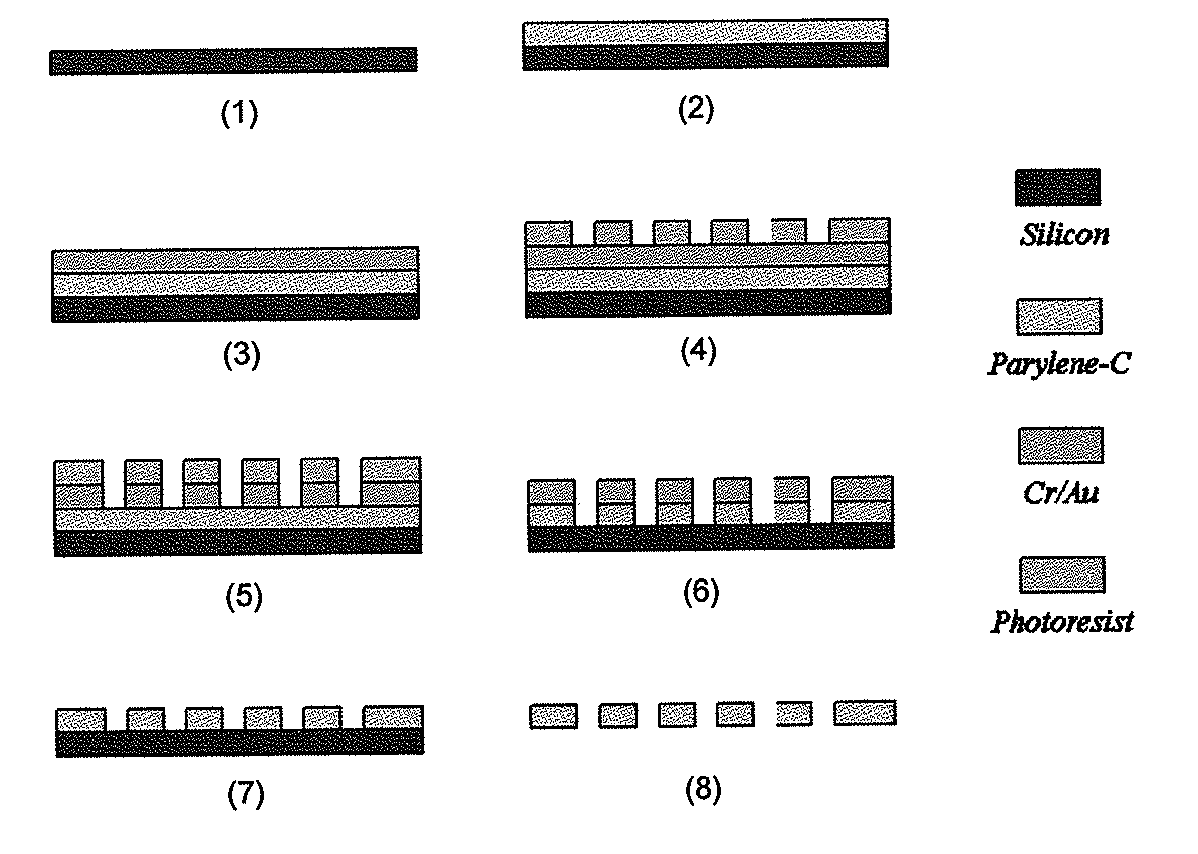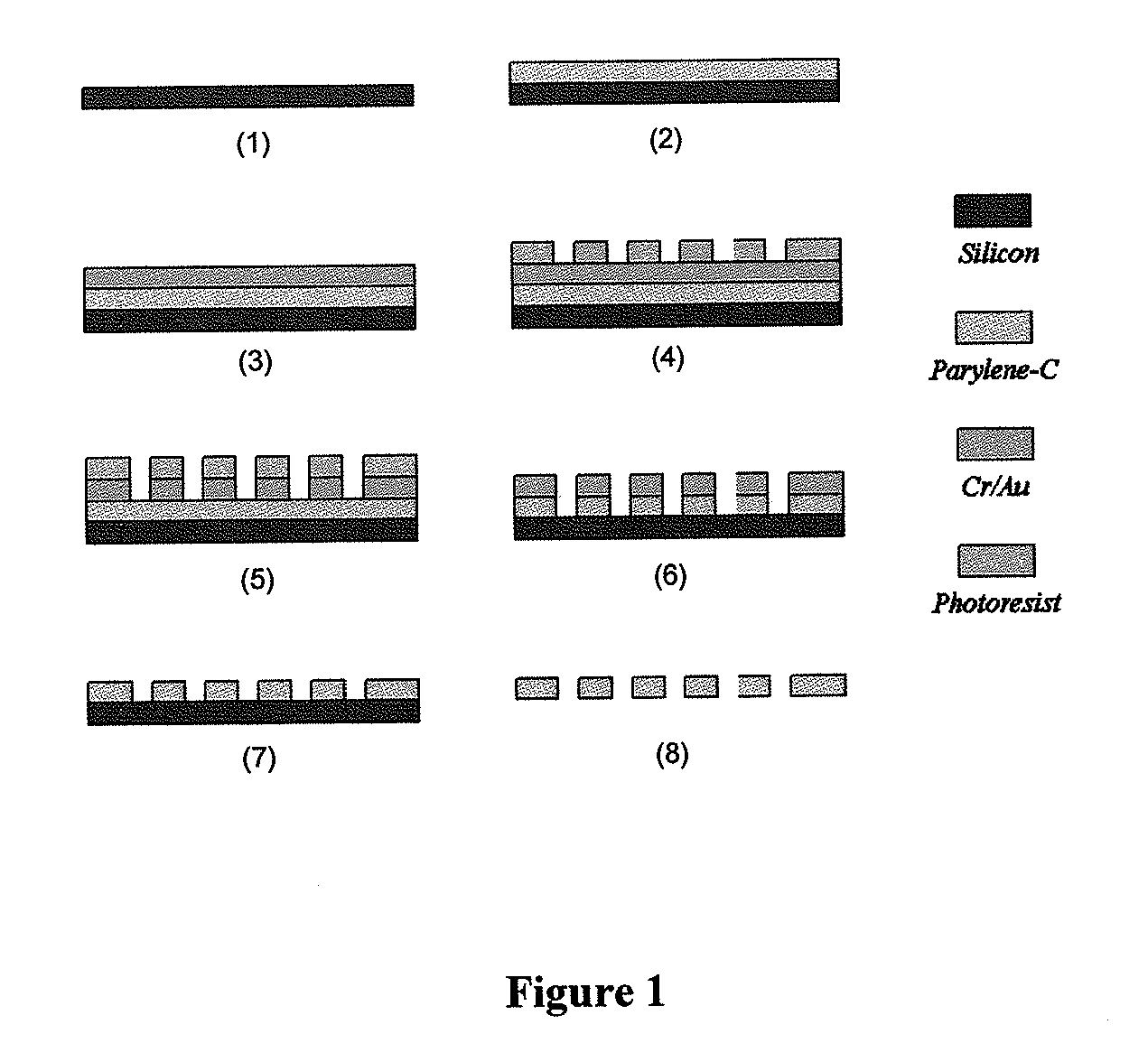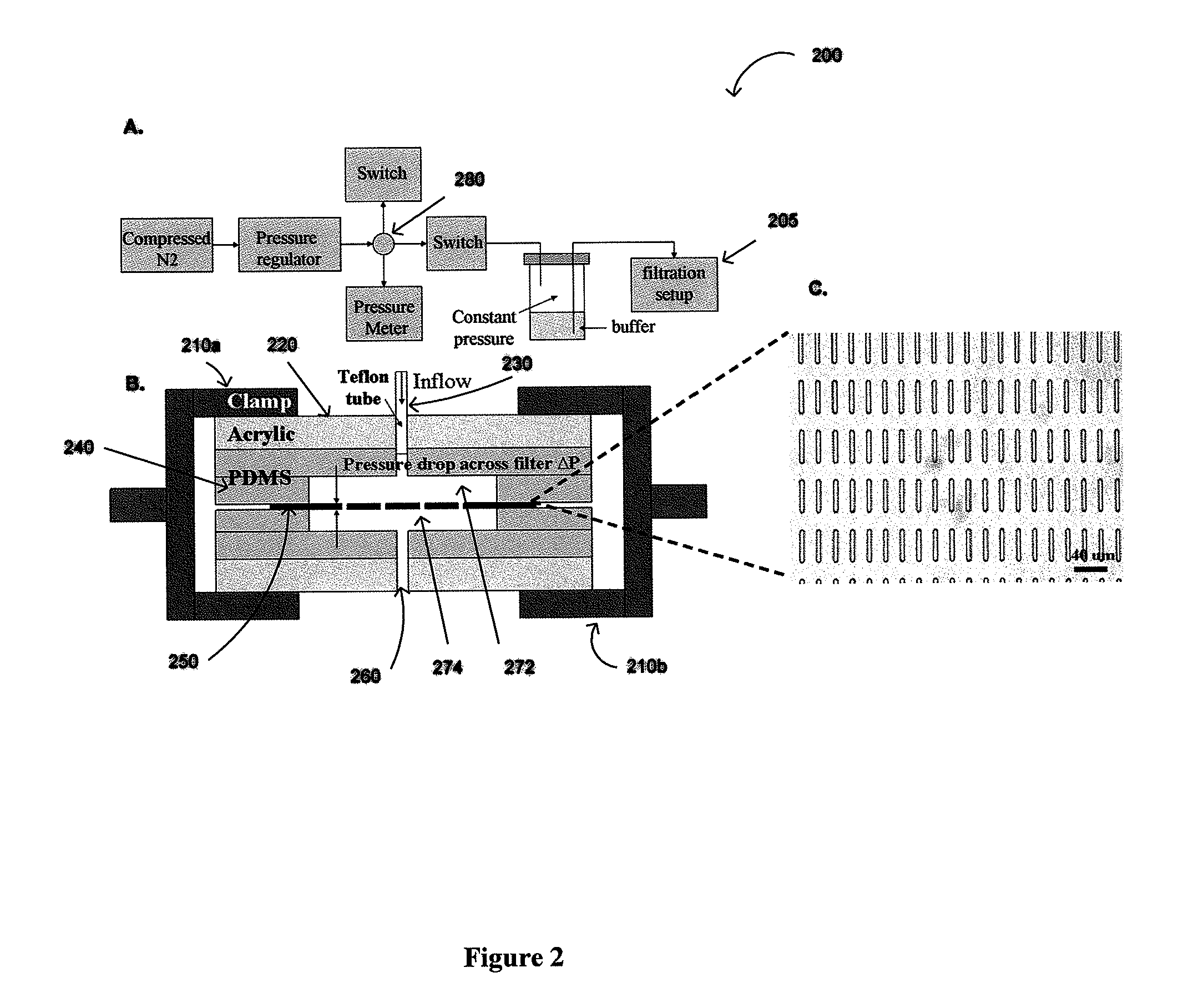Method for cancer detection, diagnosis and prognosis
a cancer and prognosis technology, applied in the field of cancer detection, diagnosis and prognosis, can solve the problems of ctc detection, ctc isolation and (2), requiring expensive reagents and equipment, and a relatively small population of ctcs, and achieves rapid and efficient capture of circulating tumor cells, greater than 90% cell viability, and greater capture efficiency
- Summary
- Abstract
- Description
- Claims
- Application Information
AI Technical Summary
Benefits of technology
Problems solved by technology
Method used
Image
Examples
example 1
Production of Parylene-C Slot Microfilter System
Filter Fabrication
[0067]As shown in FIG. 1, a parylene-C membrane filter was prepared according to the following processes.[0068]1. Prime silicon wafer as substrate.[0069]2. Coating of 10 μm parylene-C.[0070]3. Ebeam deposition of 10 nm Cr and 200 nm Au.[0071]4. Spin-coating of AZ1518 photoresist and lithography to form pattern.[0072]5. Wet-etching of metal layers using photoresist as mask.[0073]6. Reactive Ion Etching (RIE) of parylene-C to form slots (an array of 30,401 slots), using[0074]metal as mask.[0075]7. Strip off metal mask.[0076]8. Parylene-C membrane is peeled off from silicon substrate.
Constant Pressure Fluid Delivery System
[0077]Pressure from a nitrogen tank was reduced below 1 psi by a two-stage regulator (FIG. 2) and further down regulated accurately by adjusting a needle valve to 0.1-0.13 psi. A 15 ml conical tube containing the sample was connected as a reservoir. The filter was sandwiched between two thin pieces of p...
example 2
Use of Parylene-C Slot Microfilter-Based Enrichment of Blood CTCs
Capture Efficiency, Cell Viability and Enrichment:
[0078]PC3 and DU145 human prostate cancer cell lines were stained with Calcein-AM fluorescent dye, and 10 cells were spiked into 1 ml human blood obtained from healthy volunteers. After filtration, captured cells were co-stained with Propidium iodide (PI) on filter and counted under a fluorescent microscope (Zeiss Imager.Z1 microscope) with Axiovision software. Viable Calcein-AM-retaining cells were fluorescent green while dead cells were fluorescent red by PI.
Capture efficiency was calculated as:
Captureefficiency(%)=cancercells(green+red)onfiltercancercellsspikedintoblood×100
Cell viability was calculated as:
Cellviability(%)=greenfluorescentcellstotalcapturedcancercells(green+red)×100
Enrichment was determined by staining and counting the PBMCs remaining on filter with Acridine Orange and was calculated as:
Enrichment(fold)=(cancercells / PBMCs)onfilterpost-filtration(cance...
example 3
Quantitative PCR (QPCR) Telomerase Activity Assay
Telomeric Repeat Amplification Protocol (TRAP) Assay
[0083]Telomerase activity from cell extracts was analyzed using a previously described real-time PCR-based telomeric repeat amplification protocol (TRAP) (Xu T, Xu Y, Liao C P, Lau R, Goldkorn A. Reprogramming murine telomerase rapidly inhibits the growth of mouse cancer cells in vitro and in vivo. Mol Cancer Ther 2010; 9:438-49). The microfilter with captured cells was lysed in TRAPeze® 1× CHAPS Lysis Buffer (Millipore, 5 Temecula, Calif.), and 5 μl of cell lysate per reaction was added for each sample. For each reaction, DU145 cell lysates were used as standard controls in parallel.
[0084]QPCR telomerase activity assay was carried out as described below.
1. TS oligonucleotides (5′ AATCCGTCGAGCAGAGTT, 8 ng / μl) and 50 μM of each dNTPs are added to the cell lysate and incubated on a Bio-Rad MyiQ Thermocycler system for 30 min at 30° C. followed by inactivation of telomerase at 95° C. fo...
PUM
| Property | Measurement | Unit |
|---|---|---|
| pressure | aaaaa | aaaaa |
| thickness | aaaaa | aaaaa |
| pressure | aaaaa | aaaaa |
Abstract
Description
Claims
Application Information
 Login to View More
Login to View More - R&D
- Intellectual Property
- Life Sciences
- Materials
- Tech Scout
- Unparalleled Data Quality
- Higher Quality Content
- 60% Fewer Hallucinations
Browse by: Latest US Patents, China's latest patents, Technical Efficacy Thesaurus, Application Domain, Technology Topic, Popular Technical Reports.
© 2025 PatSnap. All rights reserved.Legal|Privacy policy|Modern Slavery Act Transparency Statement|Sitemap|About US| Contact US: help@patsnap.com



